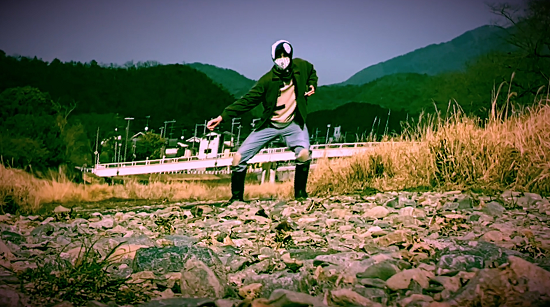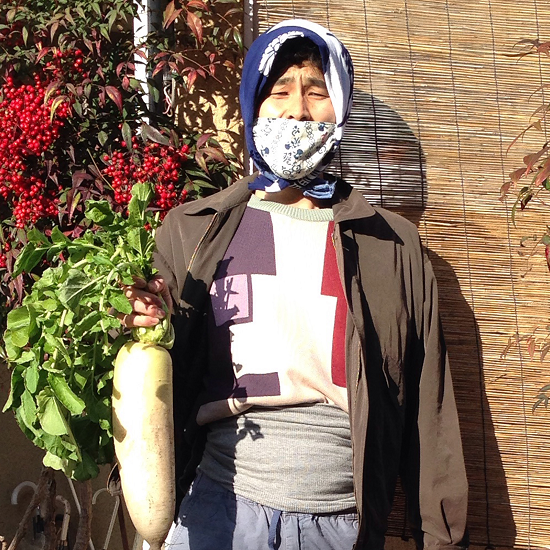There’s a concept in Japanese culture called Onkochishin. A combination of the words for ‘new knowledge’ and ‘to visit the old’, it can be roughly translated to ‘creating new ideas from studying the past,’ or ‘new wisdom in old ways’. You can see it in the country’s combination of extreme technological advancement and deep tradition, or in a scroll hanging in a modern hotel room or in the unlockable ‘onkochishin’ set of clothes in the video game Rainbow Six Siege, which dresses a character who wields a rocket launcher in traditional kyūdō archery uniform.
It’s Onkochishin that that drives producer Daisuke Iijima, on his new album as Jap Kasai, OWN ℃, which is ostensibly a combination of Japanese traditional music and modern electronic production. Cutting up vocals sourced from Ondo – a form of folk often defined by a distinctive swing rhythm – and Minyo – old, often domestic songs tied to their local regions – with skittering juke and footwork beats. To paint the record simply as a mash-up is to do it a disservice, however, for it’s rich in complexity. Rather than clashing up against each other like two incompatible extremes, the two are slickly intertwined. The music is often harsh and off-kilter, staggering along in fits and starts, but never feels disparate – old and new lurching forwards in tandem. The vocal samples Iijima employs, which reverberate with deep soulfulness, are elevated, not dampened, by the skittering beats.
Iijima’s father was from Tokushima, where the Awa Dance Festival, or Awa Odori, is held annually, and which the family would often attend. The largest of its kind in Japan, it’s Tokushima’s iteration of the traditional Bon Odiri, a festival where the spirits of ancestors are said to visit their living relatives. “Ondo is the music used during the Bon Odori,” he explains, a ceremony in which “people dance in a circle around a Yagura, a tall wooden stage. The spirits of the ancestors are said to have returned to this world, so we entertain them with Bon Odiri.” Growing up in Chiba prefecture, Tokyo, sometimes he would also travel to Koenji, where another famous Bon Odiri is held, to practise his dancing. “The practise was hard, but after my father would take me to McDonalds. I used to go to practise to eat a Teriyaki McBurger. It’s good memories!”
Attracting over a million visitors every August, Tokushima’s Awa Odori supposedly dates back to 1586, and a lavish party thrown by the area’s feudal lord to mark the opening of Tokushima Castle. Drunk on sake, the locals started to dance and sway to an impromptu rhythm played on whatever instruments were at hand. The song they were said to have sang is still recited today; its chanted refrain translates to ‘The dancers are fools / The watchers are fools / Both are fools alike / So why not dance?’
“During the Awa Odori, the population of Tokushima triples in size,” Iijima says of the festival today. The star attractions are the Ren, dance troops who parade through the town, each performing their own unique choreography. “At the main venue there is an audience area to watch the skilled dancers, but on the other hand, dances are often performed on the street. Sometimes they are performed in a troupe, and sometimes they are danced in a circle going round and round, and anyone can join in. The basic dance of the Awa Odori is simple and easy to join in. I think this is the true essence of Awa Odori, you can actually take part in it, not just watch it.”
Iijima first started playing in a band when he was 19, inspired by garage rock and Spacemen 3, and then was in and out of a number of other projects until he ended up a solo artist. “In 2014 I started to search for my style,” he says. “It was around that time that I saw a DJ specialising in Ondo, called DJ Fukutake.” He was also developing a love of footwork and juke music, the likes of Foodman, Jlin and especially RP Boo. “His performance in Tokyo in 2016 is still a shock to me. It was really crazy music.” Sun Araw was another inspiration. “I liked his dislocated beats, strange sounds and goofy atmosphere. I think he has a strange sense of humour. It’s also very danceable music for me.”
Before long, he started to draw parallels between the electronic music he was listening to, and his memories of Tokushima. “The music of the Awa Odori is mainly made up of nakimono – a gong – flutes, shamisen and taiko drums. The shuffling, rapid rhythms of the narimono are combined with the slow, polyrhythmic beat of the taiko. Fast and slow rhythms coexist in the same rhythm. That was the inspiration for me,” he says. “Today’s R&B uses ‘slow and fast’ beats that have passed through juke, footwork and trap.” He also thought of Minyo singing, where long sung notes vibrate between pitches. “By adding a new interpretation, I thought I could make [my own] ‘slow and fast’ beat.”

As much inspired by dance, as by music, he also found similarities in the styles’ physicality. “Footwork dancers make a circle, don’t they? After one dancer has danced, the next dancer is nominated, and the nominated one performs the dance. In the Awa Odori, the same kind of thing appears. The dancers make a circle and take it in turns to perform the dance, crossing the circle.”
His concept firm, Iijima set about sourcing his samples, plumbing YouTube for performances of ancient folk songs. There are dozens, so he takes ‘Sako Ondo’, where gorgeous melodic vocals float airily around a gradually intensifying beat, as an example. “I sampled the vocal from a Min-yo called ‘Kariboshikiri-uta’, a Minyo from Takachiho region in Miyazaki prefecture. From the end of September to the beginning of October, people work on the mountain slopes to cut down the weeds. This work is called ‘Kariboshi’, so ‘Kariboshikiri-uta’ is sung at this time. The dried weeds are used to make roofs, fertiliser for the fields and food for the livestock.” Crucially, he does not muddy that original atmosphere of steady, honest work with the production he adds to the mix, rather intensifies it with a steady, booming drum.
OWN℃’s final nod to Onkochishin is in its title. It can be read in Japanese as ‘Ondo’, Iijima points out, and can also refer to one’s personal body temperature – a nod to the concerns of the coronavirus pandemic. Most importantly, however, it’s pronounced as a homophone of Woun, the name of his maternal grandmother. “She’s been a farmer all her life. In the last couple of years I also started a very small farm. My mother is here because of my grandfather in Fukushima. My father is here because of my grandmother and grandfather in Tokushima” he continues. “My mother and father are the reason I am here. I am deeply moved to think that I am here because of my ancestors.”
Jap Kasai’s OWN℃ is out now via Chinabot


